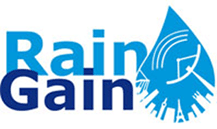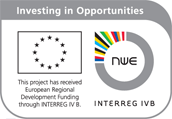Implementation of rainfall data and flood modelling into urban water management
Objective
The objective of WP4 is to use rainfall data and flood model results acquired in WP2 and WP3 to analyse the urban water systems at the pilot locations and develop solutions for better stormwater control and flood prevention. This becomes possible through the availability of detailed rainfall data, while in the current situation water managers rely on rainfall data from a single or a few rain gauges that are unable to capture rainfall variations within a city area. Water managers will use the new, detailed information on peak rainfall and local flooding to see how their water systems react to local, critical rainfall. During an international project meeting (planned in spring 2012) they will present existing solutions at the pilot locations to cope with urban pluvial flooding and discuss advantages of their respective solutions. The aim it to broaden the scope for possible solutions for the partners. Based on the results of this meeting and the detailed rainfall and flood data, water managers will develop solutions and test their effectivenes. The following solutions will be investigated, among others:
- early warning systems based on fine-scale flood prediction (experience in UK);
- real-time operational strategies of storage basins and pumping stations to maximise rainwater storage (experience in France and Belgium);
- upgrading the capacity of urban water systems (larger pipes, canals and basins, especially those that reach the end of their lifetime; experiences in NL).
National meetings will be organised to disseminate findings to water managers of others cities in the NWE regions. The end users of the rainfall equipment, data and models will be trained so they will be able to take over the project deliverables and to resume responsibility in operation and management.
Actions and investments
- Action WP4A14: Analysis of the current stormwater and flood control techniques at the pilot locations, as a starting point for development of improved solutions. Intercomparison of current state at pilot locations and knowledge exchange between partners during international project meeting (spring 2012). Setting up of National Observer Groups in each partner country to assure dissemination of project results to other cities and water authorities and training and capacity building.
- Action WP4A15: Analysis of heavy rainfall event data and water system functioning at the pilot locations based on data from WP2: identification of weak spots in the water systems at the pilot locations. Analysis of flood data from WP3 and cross-check with results of rainfall data analysis to identify flood-prone locations and relations with local heavy rainfall characteristics, i.e. under what conditions the locations flood. This is a starting point for the development of effective solutions (action16)
- Action WP4A16: Development of solutions for flood-prone locations and testing of the solutions based on rainfall data and flood models from WP2 and WP3. Inter-comparison of developed solutions for pilot locations during international project workshop (spring 2015). Evaluation of the results and practical applicability of fine-scale rainfall and flood data in water management practice based on interviews with relevant partners. The results of testing and evaluation will be discussed at the final project conference, where all partners involved in testing at the pilot locations and water managers from other cities in the EU will participate.
- Action WP4A17: Training material on implementation of rainfall and flood data for development of flood control solutions will be prepared based on the results for the pilot locations. Training will be given during national observer meetings that will be held in each of the participating countries
Transnational added value
The implementation of rainfall and flood data data in urban water management practice in WP4 will bring together experiences from the pilot locations in the partner countries. Cities and water authorities will meet to compare their existing solutions for urban pluvial flood protection. They will all implement the fine-scale rainfall and flood data to analyse their water systems and find relations between local conditions, rainfall conditions and pluvial flooding. By comparing the results from different pilot locations they will discover how policies and types of systems used in different countries are effective and whether they could be applied in their own practice. This will extend their scope on possible solutions, in policy as well as in technical solutions. The involvement of operators as well as policy makers will from cities and water authorities at the pilot locations and international meetings will ensure that new insights will actually be implemented.
As water and city authorities develop solutions for the partner locations, based on the new, fine-scale rainfall and flood data, this broader scope will help to come up with innovative solutions that they would otherwise not have thought of. Partners will discuss the developed solutions (emergency warning, real-time operation of storage, infrastructure capacity, adapted policies) during the international project meeting (spring 2015) and during national observer meetings, where other water and city authorities are invited. Thus, spreading and wider application of the solutions in policies and techniques by other cities in the partner countries will be promoted.
Who is doing what ?
- WP4A14: Water managers and operators at the pilot locations will bring forward data about their water systems and flood control techniques. Exchange of the results will take place during the international meeting for WP4 in which representatives from the partners working on the pilot locations will participate. Partners in each of the partner countries will set up national observer groups. The groups will convene once per year during the project period.
- WP4A15: Water managers at the pilot locations (Leuven, counties of Val de Marne and St.-Denis, Rotterdam, Inner London West) will use the rainfall data acquired in WP2 and flood data from WP3, especially those acquired during heavy rainfall events, to analyse the performance of their systems under heavy rainfall conditions and identify weak spots. They will be assisted in this by the research institutions (K.U. Leuven, ICL, ParisTech, TU Delft).
- WP4A16: Water managers at the pilot locations (Aquafin, Val de Marne, StDenis, water management department of Rotterdam city, Inner London West) will develop solutions for flood-prone locations, assisted by the research institutions. The solutions for the pilot locations will be presented and intercompared during the international meeting. Interviews will be conducted by representatives from the consortium in the respective countries, preferably from two different institutions. Water managers at the pilot locations will be interviewed; besides water manager partners in the consortium this will include observers from other cities.
- WP417 : Partners from all countries will provide information for the creation of training material and consortium partners as well as observers will participate in the training meetings for national observer groups.
Outputs
- WP4A14: Report with overview of current stormwater and flood control techniques at the pilot locations, as a starting point for development of improved solutions and intercomparison of current state at pilot locations. International project meeting (spring 2012) on exchange of existing solutions between city and water authorities in the consortium. National observer groups in each of the pilot countries; these groups will be coupled with existing platforms whereever possible (see action 14).
- WP4A15: List of flood-prone locations for each of the pilot locations and relations with local heavy rainfall characteristics, i.e. under what conditions the locations flood. Each of the locations is categorised according to: the type of heavy rainfall event that causes flooding, the type and extent of flooding and expected flood damage, relation to relevant local conditions such as ground level variation (e.g. location is local depression), urban density, availability of local rainfall storage, acceptability of flooding at the particular location.
- WP4A16: Customised solutions for the pilot locations and test results for the solutions based on simulations with the models developed in WP3. A ranking of priority solutions will be set up in relation to local and the intercomparison discussion at the international meeting. This ranking will be used to actually implement the solutions (during project period and beyond) and will be disseminated during national meetings and the final project conference.
- WP4A17: Training material for national observer meetings summarising guidelines for practical implementation of fine-scale rainfall data and flood modelling urban water management. Training material will consist of manuals for rainfall acquisition, use of the detailed urban flood model and a guideline with recommendations for practical implementation in relation to application conditions, based on the outcomes of Action 16 and interviews with water managers.



